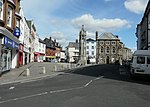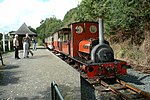Eagle House Hotel

Eagle House Hotel is a Grade II* listed building located in Castle Street, Launceston, Cornwall. Formerly a townhouse, it is now a hotel and is built in the Georgian style in red brick.Charles Causley, Launceston's most renowned poet, wrote about the statues outside the property.The building dates back to 1764, having been commissioned as a townhouse by Coryndon Carpenter, a former mayor of Launceston and the constable of Launceston Castle. Reputedly the house was partly financed by a £10,000 lottery win. In 1963 the building was converted into a hotel, also equipped with a restaurant area. By 2015 the building had fallen into disrepair and was considered for conversion back into a private house. It was eventually bought by the current owners, who renovated the property as a hotel with restaurant. It reopened in spring 2017.
Excerpt from the Wikipedia article Eagle House Hotel (License: CC BY-SA 3.0, Authors, Images).Eagle House Hotel
Castle Street,
Geographical coordinates (GPS) Address External links Nearby Places Show on map
Geographical coordinates (GPS)
| Latitude | Longitude |
|---|---|
| N 50.6381 ° | E -4.36246 ° |
Address
Eagle House Hotel
Castle Street
PL15 8BA
England, United Kingdom
Open on Google Maps





